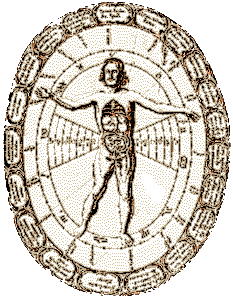
MACROCOSM AND MICROCOSM
The objects in the Curiosity Cabinet formed a microcosm--a world in miniature--which provided insight into the nature of the macrocosm--the cosmos in its incomprehensibly immense entirety. Through possessing and understanding the representation of the world provided by the curiosity cabinet, the viewer gained a sense of control and power over the larger world outside.
 The collections of objects created in the sixteenth century also served to represent
the collector himself--as do contemporary collections--demonstrating the collector's
status, wealth, education, and power to his peers. They also displayed the resources
of a local province within the context of the greater world. The relationship
between the collection and its collector was seen as having a deeper significance,
however; the human body itself was believed to be a microcosm, an encapsulation of
cosmic dynamics. As the collection stood in relation to the world, so stood the
viewer in relation to the collection, a microcosm within a microcosm. The curiosity
cabinet, therefore, served as a mirror reflecting the viewer as well as the outside
world, mediating between the microcosm of the viewer and the macrocosm of the
universe.
The collections of objects created in the sixteenth century also served to represent
the collector himself--as do contemporary collections--demonstrating the collector's
status, wealth, education, and power to his peers. They also displayed the resources
of a local province within the context of the greater world. The relationship
between the collection and its collector was seen as having a deeper significance,
however; the human body itself was believed to be a microcosm, an encapsulation of
cosmic dynamics. As the collection stood in relation to the world, so stood the
viewer in relation to the collection, a microcosm within a microcosm. The curiosity
cabinet, therefore, served as a mirror reflecting the viewer as well as the outside
world, mediating between the microcosm of the viewer and the macrocosm of the
universe.
 |
 |
{Essays} {Gallery} {Microcosms} |
 |